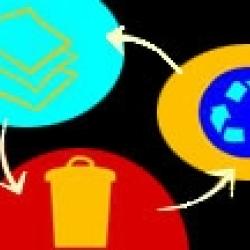Source Institutions
Add to list Go to activity

In this activity, learners collect, categorize, weigh and analyze classroom trash and discuss ways that engineers have helped to reduce solid waste. Learners make predictions on the types of trash that they will collect in a week and sort the trash they collect into categories (food, paper, plastic, etc.) and subcategories (re-useable, recyclable, and non-recyclable). Learners calculate the total mass of a group of items, explain how accumulating solid waste affects the environment, and investigate the attitudes about solid waste in developed and undeveloped countries.
- 5 to 10 minutes
- 1 to 2 hours
- $1 - $5 per group of students
- Ages 8 - 11
- Activity, Lesson/Lesson Plan
- English
Quick Guide
Materials List (per group of students)
- Classroom trash (1 week's worth)
- Multiple trash cans/bin for sorting different types of trash (recyclable and non-recyclable paper, plastic, metals, glass, food waste, miscellaneous items)
- 3 plastic garbage bags (e.g. grocery sacks)
- Bathroom scale
- Rubber/latex gloves
- Let's Talk Trash Worksheet
Subjects
-
Earth and Space Science
-
Earth Processes
- Weather and Climate
-
Earth Processes
-
Engineering and Technology
-
Engineering
- Environmental Engineering
-
Technology
- Manufacturing
-
Engineering
-
Life Sciences
-
Ecology
- Human Impact
-
Ecology
-
Mathematics
-
Data Analysis and Probability
- Data Analysis
- Data Collection
- Data Representation
- Measurement
-
Data Analysis and Probability
-
Physical Sciences
-
Structure and Properties of Matter
- Mass and Weight
-
Structure and Properties of Matter
-
The Nature of Science
-
Science and Society
- Risks and Benefits
-
The Scientific Process
- Conducting Investigations
- Gathering Data
- Formulating Explanations
- Communicating Results
-
Science and Society
-
The Nature of Technology
-
Technology and Society
- Impacts of Technology
- Technology and the Environment
-
The Design Process
- Invention and Innovation
-
Technology and Society
Informal Categories
- Nature and Environment
Audience
To use this activity, learners need to:
- see
- read
- touch
Learning styles supported:
- Involves teamwork and communication skills
- Uses STEM to solve real-world problems
- Involves hands-on or lab activities
Other
Includes alignment to state and/or national standards:
Includes assesments for student learning:
This resource is part of:
Access Rights:
- Free access
By:
- Kolenbrander, Amy ; Todd, Jessica ; Schaefer Zarske, Malinda ; Yowell, Janet
Source Collection
- TeachEngineering
Rights:
- All rights reserved, Regents of the University of Colorado, 2005
Funding Sources:
- Fund for the Improvement of Postsecondary Education (FIPSE)
- U.S. Department of Education
- National Science Foundation, National Science Foundation
